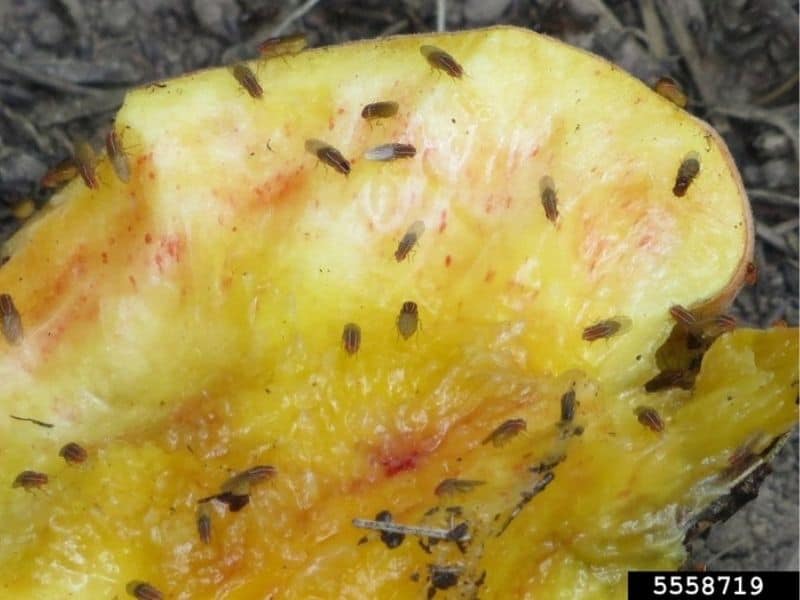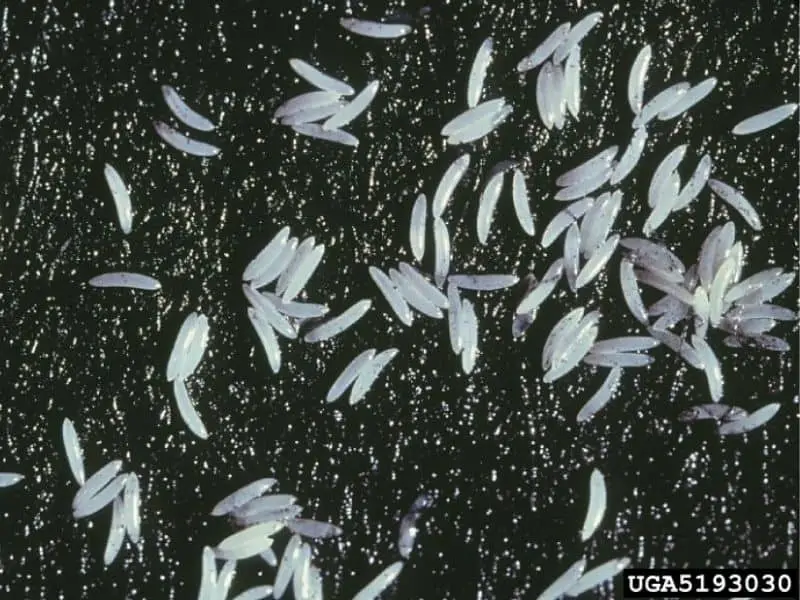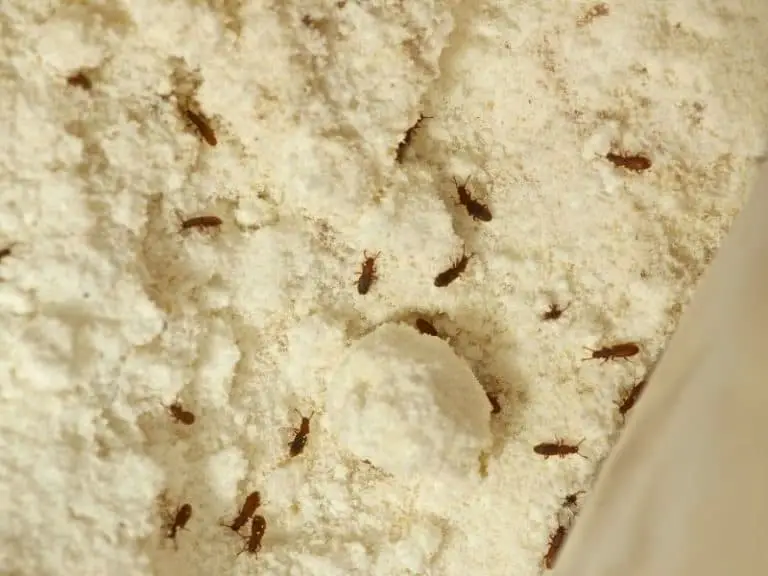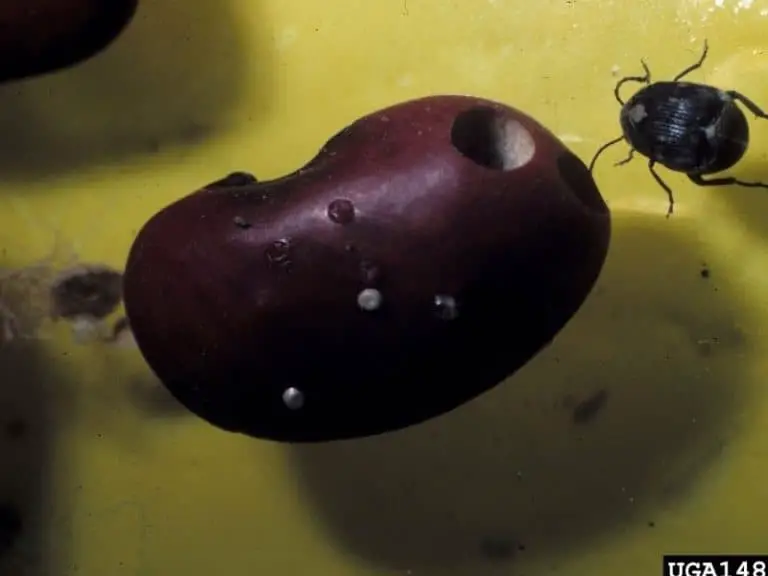What Happens if You Eat a Fruit Fly [Egg or Maggott]
Are fruit flies harmful to babies, cats, plants, dogs, food, guinea pigs, birds, hamsters? Are fruit flies harmful to humans? The short answer is both a yes and a no.
A bowl with lots of fresh and brightly colored fruits is always a welcome sight in the home, except they are a magnet to fruit flies and they make you wonder what happens if you eat a fruit fly accidentally along with your fruit.
To prevent your kitchen, dining room, and your home from being infested by these and other flying insects, you want to know what the consequences are in ingesting them and how to eliminate them.
In general, your body and immune system can protect you from the possible adverse effects of eating a fruit fly. However, in some cases, you can get food poisoning due to bacterial contamination, such as Salmonella or Escherichia coli.
Seeing a fruit fly in the kitchen or elsewhere is not a serious cause for concern. They are unsightly and can contaminate your food, but they are not main vectors of disease.
Importantly as well, they do not bite, nor do they have venomous stings. If a fruit fly bites you, then it is not really a fruit fly but a different insect species entirely, because fruit flies lack teeth and implements for a laceration.
They can be annoying, yes, but are there any real and serious problems with eating a fruit fly? Let us find out.
What Happens If You Eat A Fruit Fly?

Overall and generally speaking, no problems commonly arise from humans and animals eating a fruit fly.
If you accidentally and unknowingly fruit flies them together with your food, they most probably have died while you were chewing, crushing them to death. Swallowing them will also certainly drown or asphyxiate them.
If they ever make it alive long enough to reach your stomach, they will certainly die almost instantly upon exposure to your stomach acids, which compose some of the most potent acids in the world.
The crushing and grinding movements of your stomach will also make sure they never live, much less escape your gut in alive and one piece.
And if by some miracle they also survive your stomach (which they almost certainly won’t), they will have spent too much time in the inhospitable environment of your digestive system by the time they make it to your intestines, and will definitely not last very long.
If you are worried if they will grow inside your body and ravage it, rest assured that they only grow up to three to four millimeters, and they also do not have a long life span, either.
They are also incapable of eating their way out of your gut, much less your body, thanks to their lack of powerful teeth.
The ingestion of common insects is usually harmless; in fact, many cultures traditionally practice the regular consumption of insects.
In short, the answer to the question what would happen if you ate a fruit fly is: you’ll be fine.
But you may still be concerned if you can get ill from ingesting a fruit fly. If a food item you ate is spoiled, it can cause sickness in several ways. None of them is a direct result of the fruit fly you ate.
However, fruit flies may carry bacteria that can cause infection. Once they land on your food, they can contaminate it with these bacteria.
Where Do Fruit Flies Come From?
They usually lay eggs on rotting food or similarly spoiled or fermenting materials, and they develop into larvae, pupae, and finally adult fruit flies once they metamorphose.
Because they can go everywhere, contaminants and filth can readily attach to flies and be transported along as the flies go from place to place.
This is compounded by the fact that a lot of the things that flies want to eat are present in the garbage and other dirty environments.
Furthermore, the young fly offspring, known as larvae, develop inside fermenting fruit.
Thus, eating spoiled fruit with fruit fly larvae may result in stomachache and infection, because both the fermenting fruit as well as the larvae can be sources of contaminants and harmful bacteria.
Fruit flies will never bite you.
Therefore, if you are bitten by a flying insect, it may just look to the untrained eye like a fruit fly, but it is really not. There are other flying insects that are often mistakenly identified as fruit flies.
Gnats are one of them. Are gnats on food safe to eat? They are also generally not harmful if accidentally ingested with food.
Fruit flies are roughly one-eighth of an inch in size, and they fly in a fluttering motion, in contrast to other insects that zoom while flying.
Fruit flies look like smaller houseflies, with a caramel brown color. It also has the characteristic feature of having blood-red-colored eyes.
Are Fruit Flies Carriers Of Disease?

Yes, they are. Fruit flies can bring disease and bacteria.
How did flies come to harbor these infectious microorganisms?
They like to eat rotting material, which is most often found in garbage cans, landfills, and other similar places.
Since they land and walk all over these decaying food materials and other similarly rotten stuff, the bacteria in them get into the fruit flies.
Fruit flies bring these microbes wherever they go and spread them. Once they land on your food and fruits, you run the risk of contracting these bacteria and getting sick from it.
But practically speaking, is it bad to eat a fruit fly?
The risk of fruit flies transmitting pathogenic bacteria has been found to be low, although some of them do carry them. They can transmit these to us through direct contact with our food.
Insects, including fruit flies, along with the bacteria that they carry, usually have a way of getting into our bodies, despite the best efforts to keep our food as hygienic as possible.
Flies walk all over fruits with bacteria upon landing on them; in addition, female flies embed eggs into these food items, which can cause you to ingest them accidentally.
You can help remove these eggs by thoroughly washing your fruits before you eat them.
If they somehow manage to remain in your food despite being washed, they will be instantly taken care of by your stomach acids.
What Happens If You Eat A Fruit Fly Egg?
Just like with adult fruit flies, eating fly eggs is nothing to really worry about. In fact, you’ve probably eaten insects and their eggs innumerable times in your life without you knowing it.
One example are the eggs lain by grain moths present in a lot of processed foods.
Also, when fresh foodstuffs such as vegetables and fruits are harvested from gardens and farms, they already commonly contain insects eggs on them.
It happens prior to harvesting and even afterward, even before they are packed and transported to your stores and supermarkets.
A normal human will have a functional immune system so that there is little need to worry.
It is only in the case of people with very weak immunity or those with autoimmune diseases that eating eggs could be a health risk. Healthy and normal people will easily withstand accidental consumption.
Eggs by themselves don’t cause a problem; however, insects laying eggs on your food could have walked on fecal matter before landing on your food, thus transferring poop particles there and causing some health risk.
This risk will be compounded if a swarm of flies that came from poop would cover and walk all over your food.
In addition, since flies cannot chew, they need to regurgitate or vomit digestive enzymes onto their food (which could be your food) before they start slurping it up again.
This is another source of bacterial contamination, and along with the fecal matter, theymay cause bacterial infection and poisoning.
The eggs themselves, meanwhile, will simply be obliterated by your stomach acids. They even provide you with a little protein.
The gastrointestinal tract, especially the stomach, comprises some of the harshest environments on our planet.
Its secretions are among the most potent acids on earth, which can easily kill off most pathogens, including the most harmful ones. It won’t even feel the challenge posed by fruit fly eggs.
Our stomach digests the food we eat through the secretion of hydrochloric acid, and fly eggs only have a soft covering which can be easily penetrated and destroyed by this acid, instantly killing them in most cases.
There is, however, an exception.
Some people who have ingested certain fly eggs experienced vomiting, diarrhea, abdominal pain, and cramps due to intestinal myiasis. Others experienced no symptoms.
Intestinal myiasis is caused by fly eggs present in food which have been ingested and which survived their passage inside the gut. Many species of flies can cause this form of myasis.
According to the CDC or Centers for Disease Control & Prevention, such an infestation can cause some symptoms.
It reported a case in Washington of a one-year-old girl whose mother observed living “worms” in her daughter’s feces.
These “worms” were later identified as maggots or larvae of a fly belonging to the species Muscina stabulans, known as false stable flies.
The infestation occurred in the gastrointestinal tract of the girl after she ate some overripe bananas which contained unhatched fly eggs.
The said bananas were hanging in the family’s kitchen and were left there for the flies to freely lay their eggs. By the time the girl ate the bananas, they were already infested with fly eggs.
Nonetheless, the girl proved to have no symptoms, and the infestation cleared on its own without any medical intervention.
The rest of the family were also tested to see if they were also infested, but only the girl was found to be positive.
It is important never to just eat any kind of food without ensuring that it is clean and hygienic.
In addition, the CDC’s advice is to cover all exposed fruits and thoroughly wash all vegetables and fruits prior to consuming them. It is not advisable to eat fly eggs deliberately.
What Happens If You Eat A Fruit Fly Maggot?

Aside from fly eggs, you may have also accidentally ate fruit fly larvae in the past if the food you ate was spoiled or contaminated with fly eggs and larvae. Just like with flies and fly eggs, accidental ingestion of maggots is also generally safe.
As with adult fly and fly egg ingestion, eating fly larvae or maggots can also cause bacterial poisoning and other health complications in some cases.
Maggots are fly larvae or young. They look like worms, have no leg appendages, and are generally cream or white in color.
Adult female flies can lay hundreds of eggs, each of which will hatch into a maggot.
Flies like to lay eggs in organic matter that is decaying, such as rotting or spoiled food or animal waste.
These are preferred laying sites because they serve to feed the developing maggots until they become mature flies.
Flies can land into and visit various sources of food within one day, thus getting into contact with, spreading, and transmitting many pathogenic bacteria to and from all the places that they have been in.
These include human food.
Larvae or maggots developing in contaminated food also get to ingest these bacteria, thus bringing them along when they themselves are ingested by humans.
Thus, people also get exposed to these harmful microorganisms due to eating fly larvae.
Some of the important disease-causing bacteria that maggots can transmit to humans include Escherichia coli and Salmonella.
To reduce the possibility of bacterial contamination, scientists suggest microwaving, heating, and drying maggots prior to eating them. Even then, there is presently still no sure way of eating them safely.
People will likely experience no adverse effects from ingesting fly larvae. There may be a temporary case of food poisoning due to bacterial contamination, but many of these cases resolve by themselves after a number of days.
Take note that certain people have a higher susceptibility to food poisoning. In this case, immediately see your doctor.
Best Fruit Fly Trap Product Reviews
Fruit Fly Goodbye – Best for Indoor Use

Product Description
This fruit fly killer is a gel drain treatment and a drain fly treatment and killer. It is ideal for eradicating infestations of fruit flies, sewer flies, and drain flies which are found in drains and breed in them.
It is a thick gel which clings to drains and pipes to catch drain flies. Its active natural ingredient is citronella oil, which is non-toxic.
It is ideal for use in restaurants, bathrooms, kitchens, hotels, bars, and similar establishments. It is best used during the time that drain usage is low, which is usually at the end of the working or business day.
My Review
I found that this product already took effect within a day after first application. It is very useful in eliminating infestations of unsanitary and annoying fruit flies and drain flies.
I do realize that the effectiveness of the product may be affected by the severity of the infestation. Several days of application may be needed to reduce or eliminate an area with a massive amount of flies.
One thing I noticed is that even other drain pipes should also be treated because the flies may avoid the treated kitchen pipes and emerge from other pipes in the building.
The flies also produce more offspring, and grout worms and baby fruit flies can cause a reinfestation with a new and younger population.
This may necessitate diligent reapplication to eliminate all life stages and break the cycle of fly reproduction.
Garsum Fruit Fly Trap – Best for Outdoor Use

Product Description
This product is suitable for fruit flies, gnats, whiteflies, fungus gnats, mosquitoes, and other flying insects. The pack contains 12 disposable glue traps.
It does not contain any harmful chemical pesticides that could be harmful to your family or your pets. It is an environmentally friendly product.
Its bright yellow color attracts flying insects to it and traps them with glue to control insect infestation and to break their breeding cycle.
It is ideal for use near plants and beside swimming pools and other water bodies to catch mosquitoes and gnats.
My Review
In my experience, I found that the traps became highly effective if they are placed near areas where flies are attracted to. In particular, they love fruits, so if you place them near your fruit bowl, they will certainly come and be trapped.
Another option is to bait the trap itself, so that flies will be attracted to it wherever it may be. For example, you can put small pieces of cut up fruit parts you won’t eat, such as a small banana peel portion or a fruit top.
Once you discover the secret to attracting them, the traps work so well and they are filled almost within the day.
Sticky Fruit Fly Trap – Best For Plant Protection

Product Description
This product is applicable for indoor or outdoor use. It protects plants, is non-toxic, and is odorless.
It is colored yellow, a bright color that attracts flying insects and traps them in its high-quality glue. It is specially designed to trap flying pests of plants, especially potted ones.
It is user-friendly, with a sharp bottom end that may be inserted into the soil directly without the need for hooks or ropes.
It contains no harmful drugs that can harm people or pets.
It has a long lasting effect, with an adhesive that is very strong and is made of a material that is waterproof and UV-resistant. It need not be replaced until it is entirely covered with trapped insects.
My Review
I had a recent problem with fruit flies ever since we started stocking fruits in the dining area and kitchen.
Somehow, a fully screened house and a very clean environment do not completely prevent infestation. They love going for the fruits.
I consider myself lucky that I discovered this product. It traps flies and other insects like bees to honey.
It is also nice that I can put the traps wherever I want, including areas beside the fruits where they love to congregate.
An advantage that is also a bit tricky for setting it up is the sticky part of the trap, which may become an annoying aspect during application.
But hey, that’s exactly what the traps are for, for flies to stick to them, so I cannot really complain. It would be worse if the glue is not sticky enough to contain the flies.
Related Questions
What other insects are mistakenly thought of as fruit flies?
There are several biting insects that are commonly thought to be fruit flies. These include the following: no-see-um bugs, biting gnats, fleas, and ticks.
No-see-um bugs are a general group of insects that are not easily seen by our naked eye due to their extremely small size. They are also known as sandflies. They often bite in an effective and rapid manner so that they can quickly sneak off after biting you.
Biting gnats or biting midges are small flies that are common in warm climates that inflict painful bites on humans as well as animals. Their bite causes a red and painful red fleck on your skin that resolves naturally after a number of days.
Fleas and ticks are hopping insects with no wings or any flying capability. Dog fleas can leap up to 10 inches high, which is very impressive considering that this is 200 times the length of their minuscule bodies.
Fleas and ticks subsist on blood and get their sustenance by extracting it from living hosts. Meanwhile, fruit flies only slurp on fruit juice.
What attracts fruit flies?
The scent emitted by ripe vegetables and fruits attract fruit flies. They also like subsisting on sugary drinks and alcohol.
There are also non-food substances that attract fruit flies. Cleaning supplies are consumed by fruit flies, especially when they are present as residues on moist and damp cleaning sponges and rags, mops, buckets, and wastewater.
Fruit flies only require a thin fermenting layer of material in order to grow well and lay their eggs. Thus, extreme cleanliness is essential in keeping them away.
How long do fruit flies live without food?
Adult fruit flies can only live for three or four days in the absence of food. However, they can survive for many weeks if there is an accessible source of liquid carbohydrates, such as nectar.
Sources
- http://www.bbc.com/earth/story/20160825-the-greatest-jumper-on-earth-is-probably-not-a-flea
- https://www.haleypestcontrol.com/pest-index/fruit-flies/
- https://www.medicalnewstoday.com/articles/325319
- https://www.terro.com/articles/fruit-fly-questions-answered
Medical Disclaimer: TheHomePestControl is a digital publisher and does not offer personal health or medical advice. The contents of this website are not intended to substitute for professional medical advice, diagnosis, or treatment.
Affiliate Disclaimer: As an Amazon Associate, I earn from qualifying purchases made on our website. If you make a purchase through links from this website, I may earn a commission at no additional cost to you.

![10 Things That Fruit Flies Hate [plus 15 Fruit File Repellent Plants]](https://wypestcontrol.com/wp-content/uploads/fruit-flies-hate-768x576.jpg)

